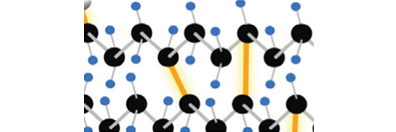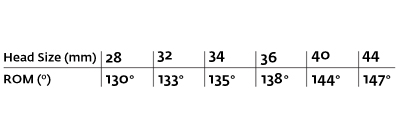X-alt™ and Biolox® delta


X-alt™ and Biolox® delta
The Perfect balance between strength and wear.
Less wear is our strength.
Where is our strength?
Optimizing crosslinking parameters provide X-alt highly crosslinked polyethylene with maximum wear properties while maintaining maximum strength characteristics. Biolox delta ceramic heads provide an increase in strength over traditional ceramics with approximately half the wear of a comparably sized Cobalt Chrome head. In combination, X-alt highly crosslinked polyethylene and delta ceramics provide the perfect synergy of maximum strength and minimum wear.
Crosslinking parameters
The goal of crosslinking is to reduce wear compared to standard UHMWPE. However, too much crosslinking can affect other properties of the material. X-alt is irradiated to 7.5 Mrad, the “point of diminishing returns”, where increasing the dose no longer provides a steep reduction in wear rate.* Thus, X-alt strikes an important balance between minimizing wear and maintaining material integrity.
*Muratolu OK, Bragdon CR, O’Connor DO. Trans Soc 1997 Biomat 20:72

delta strength properties
Significantly stronger and tougher material properties make BIOLOX delta ceramic heads much more resistant to fracture, chipping and cracking.
Size range
Biolox delta is available in 28, 32, 36, 40 and 44 mm head diameters, providing the perfect complement to X-alt highly crosslinked polyethylene.
Better Strength
Biolox ceramics The advantage of ceramic materials are especially apparent in larger diameters (≥32 mm). Simulator studies show that the rates of wear remain low despite the significantly larger friction surfaces.


Better Wear
Polyethylene- Wear Pattern
Comparison of standard compression molded (CM) polyethylene vs. X-alt™ highly crosslinked (HXL) polyethylene. The CM polyethylene was tested with 32 mm heads while the HXL poly was tested with 44 mm heads.
Biolox delta ceramic heads provide an approximate 50% reduction** in wear compared to a cobalt chrome, femoral head of the same size when used in conjunction with highly crosslinked or standard polyethylene.

**J. University of Leads (UK), 2006
- Features & Benefits
- Components
- References
X-alt™ crosslinking parameters provide an optimized balance between wear reduction and material strength. Lower wear means less chance for particle-induced osteolysis and subsequent implant loosening.
Melt-annealed for consistent material properties over time. If not removed, free radicals can bond with oxygen, causing the material to degrade. The annealing step removes free radicals, providing stability against oxidation.
Larger diameter heads increase range of motion and head “jump distance”, enhancing joint stability and helping to avoid dislocation.
Stability Against Wear
X-alt is crosslinked to address the number one cause of THA failure. Wear-induced osteolysis is caused by the body’s inflammatory reaction to polyethylene wear debris. Subsequent implant loosening is the number one cause of total hip failure. Highly crosslinked polyethylene shows dramatically reduced wear in hip simulator tests, and these results have been validated clinically.

Significant Wear Reduction
Independent wear tests of X-alt™ highly crosslinked polyethylene inserts were conducted at Loma Linda University, a lab with over 25 years of experience in orthopedic tribology. After 6.5-million cycles, representing approximately 7 years in vivo, the 44mm X-alt liners demonstrated an average of 87% less wear than the 32mm control liners. Historically, increasing head size meant increasing wear; these results show that even for a much larger head, X-alt highly crosslinked polyethylene has a drastically lower wear rate.

Crosslinking parameters
The goal of crosslinking is to reduce wear compared to standard UHMWPE. However, too much crosslinking can affect other properties of the material. X-alt is irradiated to 7.5 Mrad, the “point of diminishing returns”, where increasing the dose no longer provides a steep reduction in wear rate.* Thus, X-alt strikes an important balance between minimizing wear and maintaining material integrity.
*Muratoglu OK, Bragdon CR, O’Connor DO. Trans Soc 1997 Biomat 20:72
Maintaining Material Integrity
Lever-Out of Liner from Shell
This test simulates an extreme case of the stem impinging on the liner edge, causing the liner to be peeled from the cup. The X-alt™/FMP assembly outperformed all of the following competitive components in a study of highly crosslinked polyethylene liners.

Mechanical Properties of X-alt Highly Crosslinked Polyethylene Compared to ASTM Requirement
The data have been normalized, dividing the values by the standard. In all areas, X-alt highly crosslinked polyethylene surpasses the requirement.
Stability Against Oxidation
After crosslinking, or gamma sterilization, free radicals remain in the material. Over time, oxygen binds to these sites, causing degradation, embrittlement, possible brittle implant failures, and increased wear rates.

The melt-annealing step in the X-alt manufacturing process eliminates free radicals, providing stability against oxidation and aging.
X-alt highly crosslinked polyethylene was examined for oxidation after accelerated aging by an independent lab using Fourier Transform Infrared Spectroscopy (FTIR). No oxidation was detected. All X-alt wear, device, and material testing was conducted after accelerated aging. Accelerated aging models the material’s condition after extended service by exposing the implants to an oxygen-rich atmosphere at an elevated temperature.
Above-Melt versus Below-Melt Anneal
Polyethylene has areas of crystalline and amorphous material. Upon heating, the chains in the amorphous areas are able to slide past one another, allowing neighboring free radicals to connect and creating crosslinks. Above melt temperature, the crystalline regions become amorphous and mobile, as well, and free radicals combine throughout the entire bulk of the material. This is called “melt-annealing.” Only above melt are all free radicals removed.
Large Diameter Heads
Stability Against Dislocation
Dislocation has been reported at rates of 2-10% for primary hip replacement and up to 20% in revision hips. Dislocation is physically destructive, damaging abductor tissue. Up to two out of three recur, requiring reoperation. Clinical reports have demonstrated lower dislocation rates for larger heads.

One goal in using larger heads is to reduce neck-cup impingement. Larger heads increase the range of motion before impingement, thus decreasing the chance of subsequent lever-out dislocation.
Larger diameter heads also increase the “jump distance” or the distance the head must displace before dislocation. For instance, the jump distance for a 28mm head is 14mm, while the jump distance for a 44mm head improves to 22mm.
Range of Motion of X-alt Highly Crosslinked Polyethylene Liners
Arc of motion of the Linear® hip stem in flexion-extension for the smallest FMP Acetabular shell size available at each head size.


Standard Liners
• Neutral
• Hooded 10 degree
• Hooded 20 degree
• 28, 32, 34, 36, 40, 44mm head diameters
Offset Liners
• Neutral + 5mm
• Hooded 10 degree +5mm
• 28, 32, 34, 36, 40, 44mm head diameters
- Martell JM, Verner JJ, Incavo SJ. Clinical performance of a highly cross-linked polyethylene at two years in total hip arthroplasty: a randomized prospective trial, JOA, 2003, 18(1): 55-59.
- Digas G, Kärrholm J, Thanner J, Malchau H, Herberts P. The Otto Aufranc Award. Highly cross-linked polyethylene in total hip arthroplasty: randomized evaluation of penetration rate in cemented and uncemented sockets using radiostereometric analysis. Clin Orthop Relat Res. 2004 Dec;(429):6-16.
- Heisel C, Silva M, Schmalzried TP. In vivo wear of bilateral total hip replacements: conventional versus crosslinked polyethylene. Arch Orthop Trauma Surg. 2005 Oct;125(8):555-7.
- Dorr LD, Wan Z, Shahrdar C, Sirianni L, Boutary M, Yun A. J Bone Joint Surg Am. Clinical performance of a Durasul highly cross-linked polyethylene acetabular liner for total hip arthroplasty at five years 2005 Aug;87(8):1816-21.
- Geerdink CH, Grimm B, Ramakrishnan R, Rondhuis J, Verburg AJ, Tonino AJ. Crosslinked polyethylene compared to conventional polyethylene in total hip replacement: pre-clinical evaluation, in-vitro testing and prospective clinical follow-up study. Acta Orthop. 2006 Oct;77(5):719-25.
- Salineros MJ, Crowninshield RD, Laurent M, Wimmer MA, Jacobs JJ. Analysis of Retrieved Acetabular Components of Three Polyethylene Types.Clin Orthop Relat Res. 2007 Jul 12.
- Encore Hip Wear with FMP Cup, Peterson Tribology Laboratory, Loma Linda University. Data on file with DJO Surgical.
- Clarke IC, Good V, Anissian L, Gustafson A. Charnley. Wear model for validation of hip simulators—ball diameter versus polytetrafluoroethylene and polyethylene wear. Proc Instn Mech Engrs 211H:25-36
- Empirical Testing Corporation, Colorado Springs, CO. Mechanical Test Report Push-out, Lever-out Strength, and Torsional Stength 28mm, 36mm, and 44mm Highly Cross-linked XCEED Liner to FMP Shell. Dated August 22, 2007. Report on file with DJO Surgical.
- Postak PD, Ratzel AR, Greenwald AS. Highly Crosslinked Polyethylene Modular Acetabular Designs: Performance Characteristics. AAOS 2003. Available on the Cleveland Clinic website: http://www.orl-inc.com/hip_publications/2003/CrossLink2003.pdf.
- Correspondence from Dr. James Doi of SEAL Laboratories. Regarding Result-FTIR Measurement of FMP Liners. Letter dated March 8, 2007 addressed to Loma Linda University Peterson Tribology Laboratory. Data on file with DJO Surgical.
- Turner. Postoperative Total Hip Prosthetic Femoral Head Dislocations, CORR, 1994.
- Callaghan. Prevention of Dislocation After Hip Arthroplasty, CORR, 2001.
- Paterno SA, Lachiewicz PF, Kelley SS.The influence of patient-related factors and the position of the acetabular component on the rate of dislocation after total hip replacement. J Bone Joint Surg Am. 1997 Aug;79(8):1202-10.
- Woo. Dislocations After Total Hip Arthroplasty, JBJS, 1982.
- Alberton GM, High WA, Morrey BF. Dislocation after revision total hip arthroplasty: an analysis of risk factors and treatment options. J Bone Joint Surg Am. 2002 Oct;84-A(10):1788-92.
- Amstutz H, Le Duff MJ, Beaule. Prevention and treatment of dislocation after total hip replacement using large diameter balls. Clin Orthop Relat Res. 2004 Dec;(429):108-16.
- Peters CL, McPherson E, Jackson JD, Erickson JA. Reduction in early dislocation rate with large- diameter femoral heads in primary total hip arthroplasty. J Arthroplasty. 2007 Sep;22(6 Suppl 2):140-4.
- Beaule, Schmalzried, Udomkiat, Amstutz. Jumbo Femoral Head for the Treatment of Recurrent Dislocation Following Total Hip Replacement, JBJS (Am), 84(2): 256-63, 2002.
- Callaghan JJ, Heithoff BE, Goetz DD, Sullivan PM, Pedersen DR, Johnston RC. Prevention of dislocation after hip arthroplasty: lessons from long-term followup. Clin Orthop Relat Res. 2001 Dec;(393):157-62.
- Turner. Postoperative Total Hip Prosthetic Femoral Head Dislocations, CORR Apr;(301):196-204.
- Muratoglu OK, Bragdon CR, O’Connor DO. Trans Soc Biomat 1997 20:72
- Tower SS, Currier JH, Currier BH, Lyford KA, Van Citters DW, Mayor MB. Rim cracking of the cross- linked longevity polyethylene acetabular liner after total hip arthroplasty. J Bone Joint Surg Am. 2007 Oct;89(10):2212-7.
- Tested by Exponent, Philadelphia, PA. Characterization of Highly Cross-linked UHMWPE Final Report, Dated August 2006. Report on file with DJO Surgical.
- Data on file with DJO Surgical, ROM computer simulated using solid models